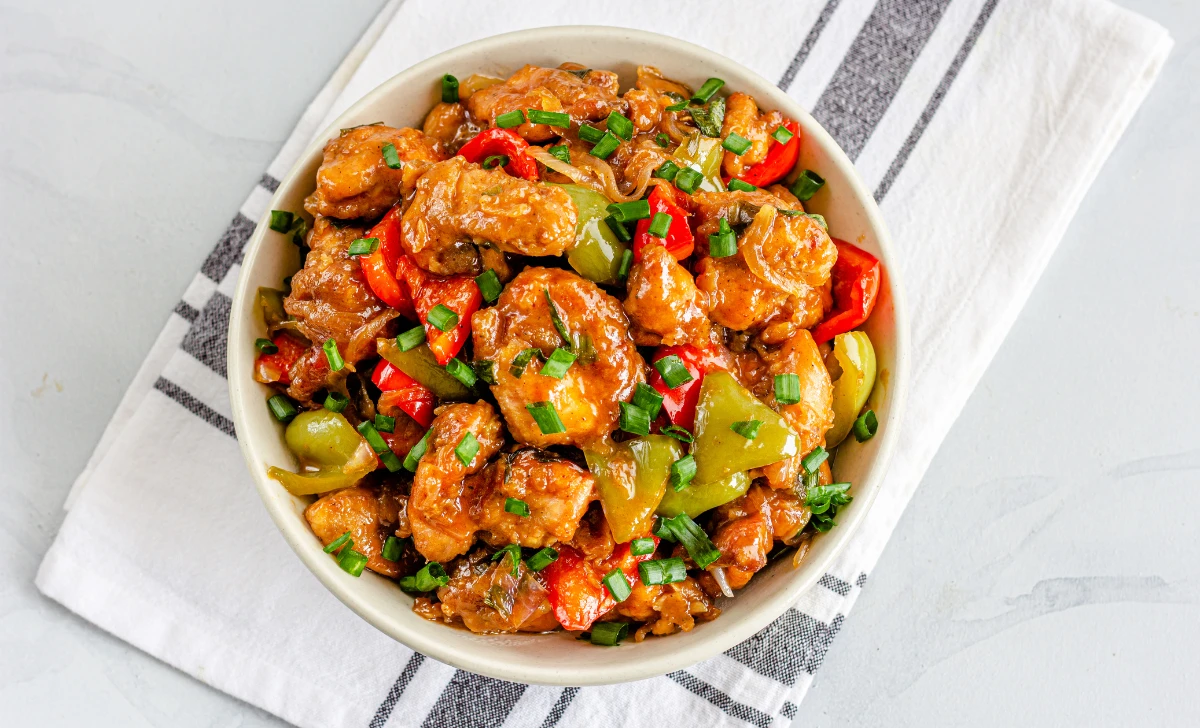Who doesn’t love a dish that perfectly balances the sweetness and tanginess in every bite? If you’re a fan of Chinese cuisine, you’re in for a treat with this delectable Sweet and Sour Chicken recipe. Whether you’re a culinary novice or an experienced home cook, this dish is sure to impress your taste buds and have you coming back for seconds. In this article, we’ll take you through every step of creating this delightful masterpiece that’s packed with flavors and textures.
[ez-toc]
History
The tantalizing aroma of sweet and sour chicken wafts through the air, instantly conjuring images of vibrant Chinese restaurants and the clinking of chopsticks. But have you ever wondered about the origins of this delectable dish? The history of sweet and sour chicken is a tale that spans centuries and continents, weaving together flavors, cultures, and culinary innovation.
Ancient Chinese Roots
While the precise origin of sweet and sour chicken is difficult to pinpoint, its roots can be traced back to ancient China. The concept of combining contrasting flavors like sweet and sour in cooking is deeply embedded in traditional Chinese cuisine. Ancient Chinese cooks were known for their expertise in balancing the yin and yang of flavors, and sweet and sour was just one of their harmonious combinations.
Early Flavor Experiments
The use of vinegar, honey, and other natural ingredients to create a balance of flavors was a common practice in early Chinese cooking. These flavors not only tantalized the taste buds but also served as remedies in traditional Chinese medicine. The art of marrying these flavors extended beyond the kitchen, becoming a fundamental principle in the philosophy of balancing opposing forces.
Journey to the West
The story of sweet and sour chicken took a significant turn with the emergence of trade routes connecting East and West. As trade flourished along the Silk Road, ingredients and culinary techniques traversed continents. Spices, sauces, and cooking methods made their way from China to other parts of Asia, the Middle East, and eventually Europe.
Adaptation and Fusion
As Chinese cuisine encountered new palates and cultures, it underwent fascinating adaptations. The sweet and sour combination, which was already a beloved aspect of Chinese cooking, found new expressions in different regions. In Western countries, particularly the United States, Chinese-American cuisine emerged, blending traditional Chinese dishes with local ingredients and preferences.
The Birth of Sweet and Sour Chicken
The birth of sweet and sour chicken, as we know it today, can be attributed to the creativity and culinary fusion of Chinese immigrants in the United States. These immigrants adapted their recipes to suit the tastes of their new surroundings while retaining the essence of their heritage. Sweet and sour sauce, with its tangy complexity, lent itself perfectly to this fusion of flavors.
From Takeout Menus to Kitchen Tables
By the mid-20th century, sweet and sour chicken had become a staple on Chinese restaurant menus in the West. Its vibrant colors, bold flavors, and playful textures made it a popular choice among diners seeking a delightful culinary experience. With the rise of home cooking and international cuisine’s popularity, sweet and sour chicken found its way into countless kitchens around the world.
Modern Interpretations
Today, the sweet and sour chicken recipe continues to evolve. From traditional versions that harken back to its Chinese roots to contemporary adaptations that experiment with different proteins and healthier cooking methods, the dish remains a canvas for culinary creativity. Home cooks and chefs alike find joy in experimenting with the balance of flavors, textures, and visual presentation.
A Flavorful Legacy
The journey of sweet and sour chicken is a testament to the power of flavors to transcend boundaries and bridge cultures. What began as a harmonious interplay of tastes in ancient China has evolved into a globally cherished dish that brings people together over a shared appreciation for exquisite cuisine. With each bite of sweet and sour chicken, we savor not only the flavors but also the rich history and culinary craftsmanship that have shaped this beloved recipe.
Time
| Step | Time |
|---|---|
| Preparing the Chicken | |
| Cutting chicken into bite-sized pieces | 10 minutes |
| Seasoning chicken with salt and pepper | 5 minutes |
| Creating the Sweet and Sour Sauce | |
| Whisking together sauce ingredients | 5 minutes |
| Batter Coating Perfection | |
| Preparing batter | 10 minutes |
| Frying to Crispy Perfection | |
| Heating cooking oil | 10 minutes |
| Frying battered chicken | 15 minutes |
| Sauteing with Vegetables | |
| Sautéing bell peppers, onions, pineapple | 10 minutes |
| Combining the Elements | |
| Mixing chicken, sauce, and vegetables | 5 minutes |
| Garnishing for Visual Appeal | |
| Adding garnishes | 5 minutes |
| Final Touches and Serving | |
| Plating and arranging | 5 minutes |
| Total Time | 90 minutes |
Please note that these times are approximate and can vary based on your cooking experience and kitchen setup. Enjoy your cooking adventure!
Ingredients
| Ingredients | Quantity |
|---|---|
| Boneless, skinless chicken breasts | 2 pieces |
| Salt and pepper | To taste |
| Cornstarch | ½ cup |
| Eggs | 2 |
| Cooking oil | For frying |
| Bell peppers | ½ of each color (red, green, yellow) |
| Onion | ½ medium-sized |
| Pineapple chunks (fresh or canned) | ½ cup |
| Ketchup | ¼ cup |
| Vinegar (white or rice vinegar) | 2 tablespoons |
| Soy sauce | 2 tablespoons |
| Sugar | 2 tablespoons |
| Green onions or sesame seeds | For garnish |
Feel free to adjust the quantities based on your preferences and desired servings. Enjoy your cooking experience!
Directions
Preparing the Chicken
- Cutting Chicken: Begin by cutting the boneless, skinless chicken breasts into bite-sized pieces. This ensures even cooking and easy biteability.
- Seasoning Chicken: Sprinkle a pinch of salt and pepper over the chicken pieces, evenly coating them. Set aside to allow the flavors to infuse.
Creating the Sweet and Sour Sauce
- Whisking Sauce Ingredients: In a bowl, whisk together the ketchup, vinegar (white or rice vinegar), soy sauce, and sugar. Adjust the quantities according to your desired level of sweetness and tanginess. Set aside to let the flavors meld.
Batter Coating Perfection
- Preparing Batter: In a separate bowl, create a batter by whisking the cornstarch and eggs together until smooth. The batter should be thick enough to generously coat the chicken.
Frying to Crispy Perfection
- Heating Cooking Oil: Heat cooking oil in a pan to around 350°F (175°C). The oil should be hot but not smoking.
- Frying Battered Chicken: Dip each seasoned chicken piece into the prepared batter, ensuring they are well-coated. Carefully place the battered chicken pieces into the hot oil, avoiding overcrowding the pan. Fry until they turn golden brown and achieve a crispy texture. Remove and drain excess oil on paper towels.
Sauteing with Vegetables
- Sautéing Bell Peppers, Onion, and Pineapple: In a separate pan, sauté the bell peppers (red, green, and yellow), onion, and pineapple chunks until they are slightly softened but still retain their vibrant colors and crunch.
Combining the Elements
- Mixing Ingredients: In a wok or a large pan, combine the fried chicken, sautéed vegetables, and the prepared sweet and sour sauce. Gently toss the ingredients together to ensure each piece of chicken and every vegetable is coated with the flavorful sauce.
Garnishing for Visual Appeal
- Adding Garnishes: To elevate the presentation, garnish the Sweet and Sour Chicken with freshly chopped green onions or a sprinkle of sesame seeds. These final touches not only add visual appeal but also enhance the dish’s flavors.
Final Touches and Serving
- Plating and Arranging: Plate your Sweet and Sour Chicken alongside steamed white rice or your preferred side dish. Arrange the chicken pieces and vegetables thoughtfully, allowing the vibrant colors and textures to shine through.
Enjoy Your Culinary Creation!
- Savoring the Delight: Now comes the most rewarding part – savoring the fruit of your labor. Dive into your homemade Sweet and Sour Chicken, relishing the harmonious blend of sweet and tangy flavors and the satisfying contrast of crispy chicken and tender vegetables.
Feel free to customize the recipe to suit your taste preferences and dietary requirements. Happy cooking and enjoy your delightful meal!
Equipment Required
Nutrition Information
| Nutrition Information | Per Serving (Approx.) |
|---|---|
| Serving Size | 1/2 of the recipe |
| Calories | Around 400 calories |
| Total Fat | About 15g |
| Saturated Fat | Around 3g |
| Cholesterol | Approximately 120mg |
| Sodium | About 800mg |
| Total Carbohydrates | Around 45g |
| Dietary Fiber | Roughly 4g |
| Sugars | About 20g |
| Protein | Approximately 25g |
Please note that these nutritional values are approximate and can vary based on factors such as ingredient brands and portion sizes. Adjustments can also be made based on any substitutions or variations you choose to incorporate. Enjoy your meal mindfully!
Tips
- Prep Ahead: Cut and season the chicken, prepare the batter, and chop the vegetables in advance. This will streamline the cooking process.
- Consistent Sizing: Aim for uniform chicken pieces to ensure even cooking and consistent texture.
- Hot Oil is Key: Maintain the oil at the right temperature for frying – too hot, and the coating might burn; too cool, and the chicken won’t get crispy.
- Drain Excess Oil: Place fried chicken on paper towels to remove excess oil and keep it crisp.
- Sauce Control: Start with less sauce and add more gradually, as you can’t remove excess sauce once added.
- Customize Flavors: Adjust the sauce’s sweetness and tanginess to your liking by tweaking the sugar and vinegar quantities.
- Healthier Frying: For a lighter version, try shallow frying or air frying the chicken instead of deep-frying.
Pros & Cons
| Pros | Cons |
|---|---|
| ✔️ Bursting with sweet and tangy flavors | ❌ Higher calorie content |
| ✔️ Customizable to taste preferences | ❌ Deep-frying can be less healthy |
| ✔️ Colorful and visually appealing | ❌ Requires multiple steps |
| ✔️ Versatile—pairs well with various sides | ❌ Contains added sugars |
| ✔️ Opportunity for culinary creativity | ❌ Can be time-consuming |
Conclusion
As we reach the culmination of our culinary journey, the tantalizing aroma and flavors of Sweet and Sour Chicken linger in the air, promising a delectable experience that’s worth every effort. From the crispy, golden-brown chicken to the medley of colorful vegetables, every bite encapsulates the perfect balance of sweet and tangy, a symphony of tastes that’s both comforting and exciting.
Embracing this recipe means embracing a chance to showcase your culinary skills and create a dish that’s not only delicious but also visually stunning. Whether you’re a novice explorer of the kitchen or a seasoned home cook, the step-by-step guide and expert tips ensure that your Sweet and Sour Chicken creation will be a triumph.
So why not seize this opportunity to embark on a flavorful adventure? Invite the vibrant flavors of this iconic Chinese-American dish into your home, impressing your loved ones with a dish that marries tradition and innovation. Let your taste buds revel in the contrast of textures and the harmony of tastes, and witness the magic that happens when sweet meets sour in a culinary masterpiece.
With the freshest ingredients and a touch of creativity, you’re just moments away from savoring a dish that’s as delightful to prepare as it is to enjoy. So go ahead, gather your ingredients, channel your inner chef, and indulge in the sheer pleasure of crafting your own Sweet and Sour Chicken. Your taste buds will thank you, and your dining table will be adorned with a vibrant, flavorful triumph that’s uniquely yours.
Facts
- 🌍 Fact 1: Globetrotting Flavors 🌍
- Did you know that the Sweet and Sour Chicken recipe has traveled across continents? Its journey started in ancient China, and as trade routes expanded, it made its way to various parts of the world. From the bustling streets of Beijing to the bustling kitchens of your home, this dish has truly embraced a global adventure.
- 🎨 Fact 2: A Canvas for Creativity 🎨
- Just like a painter’s palette, the Sweet and Sour Chicken recipe lets you unleash your creativity. With a range of protein choices, vegetable medleys, and sauce variations, you can craft a dish that’s as unique as your artistic vision. So, grab your culinary brush and let your imagination run wild!
- 📚 Fact 3: Balancing Act in History 📚
- The sweet and sour combination isn’t just confined to cooking – it’s deeply rooted in ancient Chinese philosophy. The yin and yang principles of balance and harmony extend from philosophy to the plate. As you savor the contrasting flavors, remember that you’re experiencing a culinary expression of ancient wisdom.
- 🌶️ Fact 4: From Mild to Wild 🌶️
- Looking to add a fiery kick? Spice enthusiasts can elevate the Sweet and Sour Chicken experience by incorporating chili peppers or red pepper flakes into the sauce. This fiery twist takes the dish to a whole new level, satisfying both your adventurous spirit and your taste buds’ craving for heat.
- 🔮 Fact 5: The Future of Fusion 🔮
- As cuisine evolves, so does the Sweet and Sour Chicken recipe. Chefs around the world continue to push boundaries, experimenting with healthier frying techniques, plant-based proteins, and innovative flavor profiles. This dish isn’t just a relic of the past – it’s a canvas for culinary innovators shaping the future.
FAQ’s
Can I use bone-in chicken for this recipe?
While boneless, skinless chicken is recommended for ease of preparation, you can use bone-in chicken if you prefer. Just remember to adjust cooking times to ensure the chicken cooks through.
Can I make the batter in advance?
It’s best to make the batter just before you’re ready to fry the chicken. Pre-made batter might become too thick or lose its desired consistency.
What’s the best oil for frying?
Opt for oils with high smoke points like vegetable, canola, or peanut oil. They maintain stability at high temperatures, making them ideal for frying.
Can I substitute the sugar with a healthier sweetener?
Yes, you can experiment with honey, maple syrup, or a natural sweetener of your choice. Adjust quantities to achieve your desired sweetness level.
Is it possible to bake the chicken instead of frying it?
Absolutely! For a healthier option, you can coat the chicken with the batter and bake it in the oven at around 375°F (190°C) until it’s crispy and cooked through.
What can I use as a gluten-free alternative for the batter?
You can use gluten-free flour or cornstarch for the batter to make the recipe gluten-free.
Can I use frozen vegetables if I don’t have fresh ones?
While fresh vegetables provide better texture, you can use frozen ones in a pinch. Just be sure to thaw and drain them before sautéing.
How can I reduce the sodium content in the dish?
Opt for low-sodium soy sauce and adjust the quantity of salt in the recipe. Additionally, you can use reduced-sodium ketchup or make your own sauce from scratch.
What’s the best way to reheat leftovers?
To maintain the crispiness of the chicken, it’s best to reheat leftovers in an oven or toaster oven rather than a microwave.
Can I freeze the Sweet and Sour Chicken?
While freezing can affect the crispiness of the chicken, you can freeze the sauce separately and reheat it when needed. Re-fry the chicken briefly to restore its crunchiness before combining with the reheated sauce.












Leave a Review